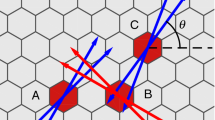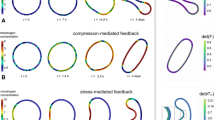Abstract
This paper concerns a second-order, three level piecewise linear finite element scheme 2-SBDF (Ruuth, in J Math Biol 34:148–176, 1995) for approximating the stationary (Turing) patterns of a well-known experimental substrate-inhibition reaction-diffusion (‘Thomas’) system (Thomas, in Analysis and control of immobilized enzyme systems, pp 115–150, 1975). A numerical analysis of the semi-discrete in time approximations leads to semi-discrete a priori bounds and an optimal error estimate. The analysis highlights the technical challenges in undertaking the numerical analysis of multi-level (\({\ge } 3\)) schemes. We illustrate the effectiveness of the numerical method by repeating an important classical experiment in mathematical biology, namely, to approximate the Turing patterns of the Thomas system over a schematic mammal skin domain with fixed geometry at various scales. We also make some comments on the correct procedure for simulating Turing patterns in general reaction-diffusion systems.


Similar content being viewed by others
Notes
See http://www.mathworks.com/matlabcentral/fileexchange/ for further details.
The physics review paper [20] has been cited 4068 times (ISI Web of Knowledge).
References
Akrivis, G., Crouzeix, M.: Linearly implicit methods for nonlinear parabolic equations. Math. Comp. 73(246), 613–635 (2003)
Akrivis, G., Crouzeix, M., Makridakis, C.: Implicit–explicit multistep finite element methods for nonlinear parabolic problems. Math. Comput. 67(222), 457–477 (1998)
Akrivis, G., Crouzeix, M., Makridakis, C.: Implicit–explicit multistep methods for quasilinear parabolic equations. Numer. Math. 82, 521–541 (1999)
Akrivis, G., Smyrlis, Y.-S.: Implicit–explicit BDF methods for the Kuramoto-Sivashinsky equation. Appl. Numer. Math. 51, 151–169 (2004)
Apostol, T.M.: Mathematical Analysis, 2nd edn. Addison-Wesley Publishing Co., Reading (1974)
Arcuri, P., Murray, J.D.: Pattern sensitivity to boundary and initial conditions in reaction-diffusion models. J. Math. Biol. 24, 141–165 (1986)
Ascher, U.M., Ruuth, S.J., Wetton, B.T.R.: Implicit-explicit methods for time-dependent partial differential equations. SIAM J. Numer. Anal. 32(3), 797–823 (1995)
Attouch, H., Buttazzo, G., Michaille, G.: Variational Analysis in Sobolev and BV Spaces: Applications to PDEs and Optimization. Mps-Siam Series on Optimization, vol. 6. SIAM, Philadelphia (2006)
Ball, J.M.: Remarks on blow-up and nonexistence theorems for nonlinear evolution equations. Q. J. Math. Oxford 2(28), 473–486 (1977)
Barrett, J.W., Blowey, J.F.: An error bound for the finite element approximation of the Cahn-Hilliard equation with logarithmic free energy. Numer. Math. 72, 1–20 (1995)
Bramble, J.H., Pasciak, J.E., Sammon, P.H., Thomée, V.: Incomplete iterations in multistep backward difference methods for parabolic problems with smooth and nonsmooth data. Math. Comp. 52(186), 339–367 (1989)
Ceniceros, H.D.: A semi-implicit moving mesh method for the focusing nonlinear Schrödinger equation. Commun. Pure Appl. Anal. 1(4), 1–14 (2002)
Chen, W.: Implicit–explicit multistep finite element methods for nonlinear convection-diffusion problems. Numer. Methods Partial Differ. Equ. 17(2), 93–104 (2001)
Chen, W.: Implicit-explicit multistep finite element methods for a semiconductor device with heat conduction. J. Math. Study 35(2), 109–123 (2002)
Chen, W.: Implicit-explicit multistep finite element methods for the semiconductor device problem. J. Syst. Sci. Complex. 16(1), 101–113 (2003)
Chen, W.: Implicit-explicit multistep finite element mixed finite element methods for the transient behavior of a semiconductor device. Acta Math. Sci. Ser. B Engl. Ed. 3, 386–398 (2003)
Chueh, K.N., Conley, C.C., Smoller, J.A.: Positively invariant regions for systems of nonlinear diffusion equations. Indiana Univ. Math. J. 26(2), 373–392 (1977)
Ciarlet, P.G.: The Finite Element Method for Elliptic Problems. In: Studies in Mathematics and its Applications, vol. 4. North-Holland, Amsterdam (1979)
Crank, N., Nicolson, P.: A practical method for numerical evaluation of solutions of partial differential equations of the heat conduction type. Proc. Camb. Phil. Soc. 43, 50–67 (1947)
Cross, M.C., Hohenberg, P.C.: Pattern formation outside of equilibrium. Rev. Modern Phy. 65(3), 851–1060 (1993)
Edelstein-Keshet, L.: Mathematical Models in Biology. Classics in Applied Mathematics, vol. 46. Society for Industrial and Applied Mathematics (SIAM), Philadelphia (2005)
Elliott, C.M., Stuart, A.M.: The global dynamics of discrete semilinear parabolic equations. SIAM J. Numer. Anal. 30(6), 1622–1663 (1993)
Emmrich, E.: Stability and error of the variable two-step BDF for semilinear parabolic problems. J. Appl. Math. Comput. 19(1–2), 33–55 (2005)
Eriksson, K., Estep, D., Hansbo, P., Johnson, C.: Computational Differential Equations. Cambridge University Press, Cambridge (1996)
Ethier, M., Bourgault, Y.: Semi-implicit time-discretization schemes for the bidomain model. SIAM J. Numer. Anal. 46(5), 2443–2468 (2008)
Frank, J., Hundsdorfer, W., Verwer, J.G.: On the stability of implicit-explicit linear multistep methods. Appl. Numer. Math. 25, 193–205 (1997)
Garvie, M.R.: Analysis of a Reaction-Diffusion System of \(\lambda -\omega \) type. University of Durham, PhD thesis (2003)
Garvie, M.R., Blowey, J.F.: A reaction-diffusion system of \(\lambda -\omega \) type. Part II: Numerical analysis. Eur. J. Appl. Math. 16(5), 621–646 (2005)
Garvie, M.R., Trenchea, C.: Finite element approximation of spatially extended predator-prey interactions with the Holling type II functional response. Numer. Math. 107, 641–667 (2007)
Henry, D.: Geometric Theory of Semilinear Parabolic Equations. In: Lecture Notes in Mathematics, vol. 840. Springer, New York (1981)
Holden, A.V., Markus, M., Othmer, H.G. (eds.): Nonlinear Wave Processes in Excitable Media. Plenum, New York (1991)
Hollis, S.L., Martin, R.H., Pierre, M.: Global existence and boundedness in reaction-diffusion systems. SIAM J. Math. Anal. 18(3), 744–761 (1987)
Hundsdorfer, W., Verwer, J.: Numerical solution of time-dependent advection-diffusion-reaction equations. In: Springer Series in Computational Mathematics, vol. 33. Springer, Berlin (2003)
Keller, E.F., Segel, L.A.: Travelling bands of bacteria: a theoretical analysis. J. Theor. Biol. 30, 235–248 (1971)
Layton, W., Trenchea, C.: Stability of two IMEX methods, CNLF-AB2, for uncoupling systems of evolution equations. Appl. Numer. Math. 62(2), 112–120 (2012)
Levin, S.A., Segel, L.A.: Hypothesis for origin of plankton patchiness. Nature 259, 659 (1976)
Lewis, P., Goodman, A., Miller, J.: A pseudo-random number generator for the system/360. IBM Syst. J. 8(2), 136–143 (1969)
Li, D., Zhang, C., Wang, W., Zhang, Y.: Implicit-explicit predictor-corrector schemes for nonlinear parabolic differential equations. Appl. Math. Model. 35, 2711–2722 (2011)
Lubich, C., Ostermann, A.: Runge-Kutta time discretization of reaction-diffusion and Navier-Stokes equations: nonsmooth-data error estimates and applications to long-time behaviour. Appl. Numer. Math. Trans. IMACS 22(1–3), 276–292 (1996)
Madzvamuse, A.: Time-stepping schemes for moving grid finite elements applied to reaction-diffusion systems on fixed and growing domains. J. Comput. Phys. 214, 239–263 (2006)
Maini, P.K.: Using mathematical models to help understand biological pattern formation. C. R. Biol. 327, 225–234 (2004)
Medvinsky, A.B., Petrovskii, S.V., Tikhonova, I.A., Malchow, H., Li, B.-L.: Spatiotemporal complexity of plankton and fish dynamics. SIAM Rev. 44(3), 311–370 (2002)
Moore, P.: Finite element multistep multiderivative schemes for parabolic equations. J. Inst. Math. Appl. 21, 331–334 (1978)
Murray, J.D.: On pattern formation mechanisms for lepidopteran wing patterns and mammalian coat markings. Phil. Trans. R. Soc. Lond. B 295, 473–496 (1981)
Murray, J.D.: On pre-pattern formation mechanism for animal coat markings. J. Theor. Biol. 88, 161–199 (1981)
Murray, J.D.: Parameter space for turing instability in reaction diffusion mechanisms: a comparison of models. J. Theor. Biol. 98, 143–163 (1982)
Murray, J.D.: Mathematical biology. Biomathematics Texts, vol. 19. Springer, Berlin (1993)
Nie, Y.-Y., Thomeé, V.: A lumped mass finite-element method with quadrature for a non-linear parabolic problem. IMA J. Numer. Anal. 5, 371–396 (1985)
Ochoa, F.L., Murray, J.D.: A non-linear analysis for spatial structure in a reaction-diffusion model. Bull. Math. Biol. 45(6), 917–930 (1983)
Pazy, A.: Semigroups of Linear Operators and Applications to Partial Differential Equations. Applied Mathematical Sciences, vol. 44. Springer, New York (1983)
Piotrowska, M.J.: Activator-inhibitor system with delay and pattern formation. Math. Comput. Modelling 42(1–2), 123–131 (2005)
Quarteroni, A.: Numerical models for differential problems. In: MS &A. Modeling, Simulation and Applications, vol. 2. Springer, Milan (2009)
Quarteroni, A., Sacco, R., Saleri, F.: Numerical mathematics. Texts in Applied Mathematics, vol. 37, 2nd edn. Springer, Berlin (2007)
Rionero, S., Vitiello, M.: Long-time behavior of the solutions of Murray–Thomas model for interacting chemicals. Math. Comput. Simul. 82, 1597–1614 (2012)
Ruuth, J.R.: Implicit-explicit methods for reaction-diffusion problems in pattern formation. J. Math. Biol. 34, 148–176 (1995)
Sgura, I., Bozzini, B., Lacitignola, D.: Numerical approximation of Turing patterns in electrodeposition by ADI methods. J. Comput. Appl. Math. 236, 4132–4147 (2012)
Temam, R.: Infinite-dimensional dynamical systems in mechanics and physics. In: Applied Mathematical Sciences, vol. 68. Springer, New York (1997)
Thomas, D.: Artificial enzyme membranes, transport, memory and oscillatory phenomena. In: Thomas, D., Kernevez, J.P. (eds.) Analysis and Control of Immobilized Enzyme Systems, pp. 115–150. Springer, Berlin (1975)
Thomas, J.W.: Numerical partial differential equations: finite difference methods. In: Texts in Applied Mathematics, vol. 22. Springer, New York (1995)
Turing, A.M.: The chemical basis of morphogenesis. Phil. Trans. R. Soc. Lond. B 237, 37–72 (1952)
Varah, J.M.: Stability restrictions on second order, three level finite difference schemes for parabolic equations. SIAM J. Numer. Anal. 17(2), 300–309 (1980)
Zhang, K., Wong, J.C.-F., Zhang, R.: Second-order implicit-explicit scheme for the Gray-Scott model. J. Comput. Appl. Math. 213, 559–581 (2008)
Zlámal, M.: Finite element multistep discretizations of parabolic boundary value problems. Math. Comp. 29(130), 350–359 (1975)
Acknowledgments
We thank James Blowey (University of Durham, UK) for some helpful comments during the preparation of this manuscript and for the comments of the anonymous reviewers.
Author information
Authors and Affiliations
Corresponding author
Appendix: Pseudo random number generation
Appendix: Pseudo random number generation
In the interests of repeatability, we give details of the pseudo random number generator D_UNIFORM_01 [37] used to perturb the coefficients \(z_{rs}\) of the double Fourier series (4.4). It is not the most efficient random number generator, but it is simple enough to be easily implemented in different languages.
We take \(z_{rs}\) equal to the \(n\)th random number \(r_n\) drawn from D_UNIFORM_01, where \(n = r + 20(s - 1)\). The random numbers are calculated recursively via
for \(n=1,2,\dots \) ‘seeded’ with \(s_0\). In all our simulations we used \(s_0=4\).
Rights and permissions
About this article
Cite this article
Garvie, M.R., Trenchea, C. A three level finite element approximation of a pattern formation model in developmental biology. Numer. Math. 127, 397–422 (2014). https://doi.org/10.1007/s00211-013-0591-z
Received:
Revised:
Published:
Issue Date:
DOI: https://doi.org/10.1007/s00211-013-0591-z




